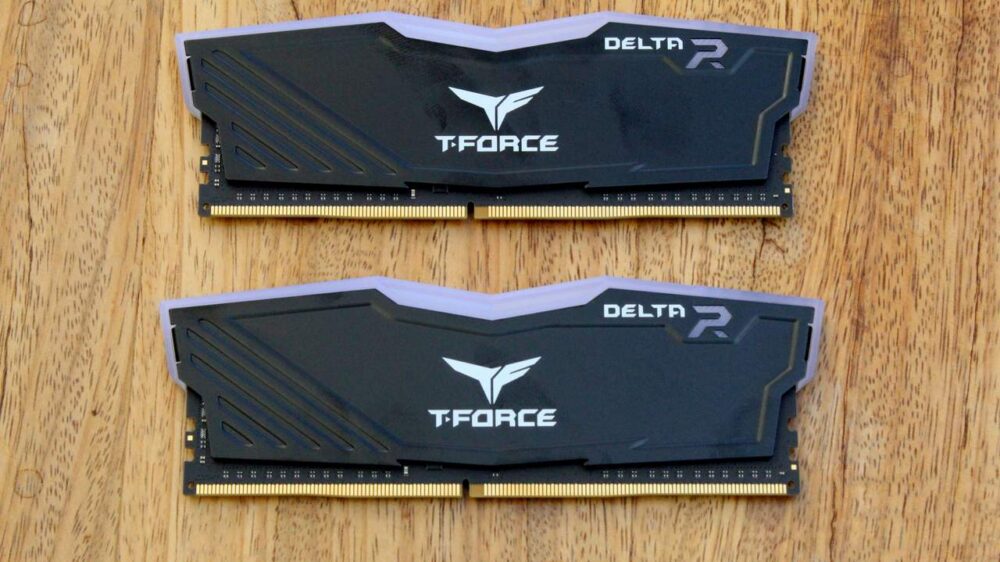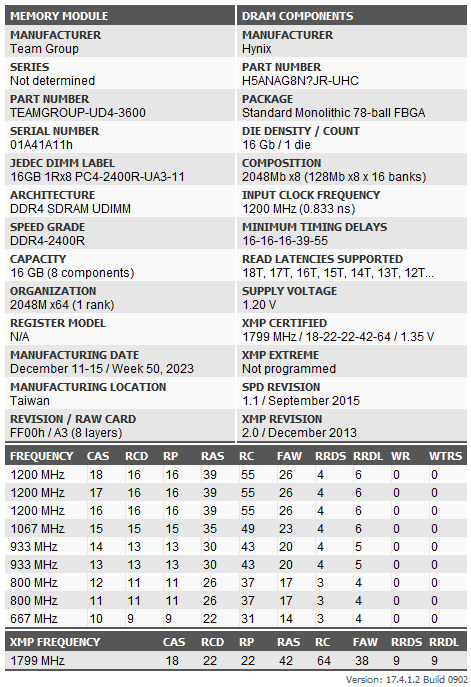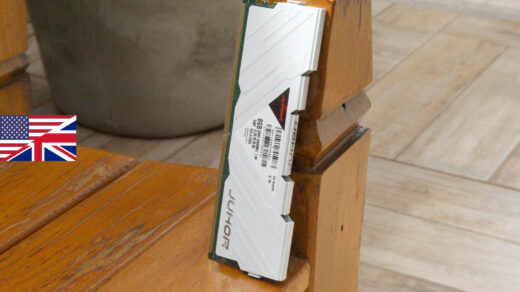Review – 2x16GB Teamgroup T-FORCE Delta RGB DDR4 3600CL18 – Hynix CJR 16-Gbit – Testing and overclocking!
In this review, we will analyze a DDR4 memory kit from Teamgroup’s Delta RGB series, which offers models ranging from 2666 to 4000 MT/s, available in 4, 8, 16, or 32 GB modules. These can be purchased separately or in kits of 8 GB, 16 GB, 32 GB, or 64 GB. The product under review is a 32 GB kit with a speed of 3600 MT/s, timings of 18-22-22-42, and an operating voltage of 1.35V.
The memory sticks come in a rectangular blister pack, allowing you to see the product and the label with its specifications directly. On the back, there is an explanation of the meaning behind “T-Force” as well as some of the memory’s features. The model code for this product is TF3D432G3600HC18JDC01.



For the heatsink, Teamgroup chose an aluminum heatsink for this series, with parts that fit into the RGB plastic diffuser. It features thermal pads that make contact with the chips, although not ideally with those located at the edges.
The tested unit has RGB lighting and, according to Teamgroup, supports software from almost all major motherboard manufacturers, including ASUS, ASRock, Biostar, GIGABYTE, and MSI.


The heatsinks can be removed from the sides using tweezers by prying the metal part upwards. It’s important to heat the memory before this procedure, as this softens the adhesive and thermal interfaces, thereby reducing the risk of damage.


Regarding the chips used in this kit, Teamgroup chose the SK Hynix H5ANAG8NCJR, or Hynix CJR for those familiar with them. Although the name is familiar from other memory modules we’ve tested, this variant is the 16 Gbit (2 GB per chip) version, which allows for the production of 16 GB “single rank” modules with only 8 chips.
Here, you can see how Thaiphoon Burner identifies these modules and also the SPD information, including the XMP profiles.
If you’re interested, the manufacturer’s page for this model can be found at this link. Also, you can buy this product from the link below. We earn a small commission from your purchase, which helps us keep producing new content!
AMAZON: https://amzn.to/3R5LwPE
Hardware used:


CPU: AMD Ryzen 5 5500
MOBO: MSI MEG B550 Unify-X (UEFI A.43O)
RAM: 2x16GB Teamgroup T-FORCE DELTA 3600CL18 – TF3D432G3600HC18JDC01 – (Thanks Teamgroup!)
GPU: Powercolor RX 6800 XT Red Devil 16 GB
PSU: Coolermaster MWE 1250 Gold V2 (Thanks Cooler Master!)
COOLER: 1STPlayer TS-360
SSD: Sandisk 120 GB SATA
Software: Windows 10 x64, TM5 0.12 1usmus, Geekbench 3.4.4, y-cruncher 1b, Horizon: Zero Dawn, Shadow of the Tomb Raider.
Testing methodology:
To determine the daily usage limits of the T-FORCE DELTA 3600CL18 with the Ryzen 5 5500, as well as the maximum frequency for benchmarks on this platform, the results have been organized into two groups for easier comprehension:
XMP: This refers to the maximum achievable by simply loading the XMP profile and increasing the clock speed/voltage, stopping at the limit for the specific Ryzen 5 5500 used. Of course, this is only if the memory being tested can reach that point.
The advantage of this approach is its simplicity, requiring no user adjustments to the timings. However, the downside is lower performance, as the motherboard automatically makes adjustments which can be quite relaxed.
24/7 with Fine-Tuning: In this scenario, manual adjustments were made to all possible timings to achieve the best possible result with daily use viability. Consequently, when possible, testing will go beyond 3800MHz to explore the memory’s limit on other CPUs or platforms that benefit from high frequencies, such as Renoir and Cezanne APUs and Intel CPUs. This aims to “assist” owners of these platforms. However, for Ryzen 3000 and 5000 based on chiplets, the adjustment that generally yields the
best performance and is simpler to achieve is one where the FCLK is synchronized with the memory, in this case, 3800MHz (RAM) and 1900MHz (FCLK). This article contains a detailed explanation of why this occurs, so reading it is recommended for a better understanding of the topic.
In cases 1 and 2, we used TM5 0.12 1usmus to check stability, Geekbench 3.4.4 and y-cruncher 1b for a better idea of performance in synthetic benchmarks, Horizon: Zero Dawn and Shadow of the Tomb Raider to gauge gains in games. We used the integrated benchmark tool at 1080p with the maximum quality profile for Zero Dawn and High for SOTTR.
For these tests, the CPU was locked at 4.2GHz with 1.25V to eliminate variations due to Precision Boost.
Timings – AMD
- XMP:
With this approach, we were able to stretch up to 4133 MT/s by increasing the voltage to just 1.45V, a considerable overclock considering the low effort involved, with all timings on automatic XMP, only adjusting the voltage and frequency.
It was also possible to load the system and complete some benchmarks at 4266 MT/s; however, it was not possible to stabilize even with 1.5V.
- 24/7 with fine-tuning:

By fine-tuning, it was possible to stabilize the memory operating at DDR4-4266, dramatically improving all subtimings compared to the XMP setting. The DDR4-3800 setting was included for those using Ryzen 3000 or 5000 based on chiplets, which tend to have this limit in 1:1:1 mode.
Regarding timings, these chips proved to be more sensitive to tRCDRD and tCL, with these being the main timings to relax if aiming to go beyond 4266. For example, to go beyond 4400, it was necessary to set tCL = 20. As for tRFC, it responds similarly to Hynix CJR 8 Gbit, hence being more relaxed than the 4 Gbit chip.
Benchmarks:
Here are the performance numbers in the memory subtest of Geekbench 3.4.4, y-cruncher 1b, Horizon: Zero Dawn, and Shadow of the Tomb Raider with the RX 6800 XT. Gains may vary depending on the platform and CPU used.
Remember that all these results passed the stability test of TM5 0.12 v3 and, at least specifically for these samples, represent something that can be used daily.




Conclusion:
The Teamgroup T-FORCE Delta 3600CL18 32 GB (2×16 GB) DDR4-3600 kit showed good compatibility with the AMD platform, functioning normally with the XMP profile without user intervention. With overclocking, it was possible to reach DDR4-4133 by simply increasing the voltage to 1.45V, which is an excellent achievement given the low effort required.
With manual tuning, DDR4-4266 CL18 was achieved with 1.5V, significantly lowering all subtimings, resulting in performance gains in benchmarks. There’s still room to push further by relaxing primary timings, reaching 4400 MT/s, but with CL20 and tRCDRD above 24, which may not always be worth it.
In terms of availability and price, the T-FORCE DELTA 3600CL18 can be found for around 70 USD, which is a competitive price compared to competitors with similar specifications and RGB lighting.
With that said, considering the results shown, we can recommend this Teamgroup kit for those looking for good DDR4 memories for daily use, featuring RGB lighting and at a reasonable price.








